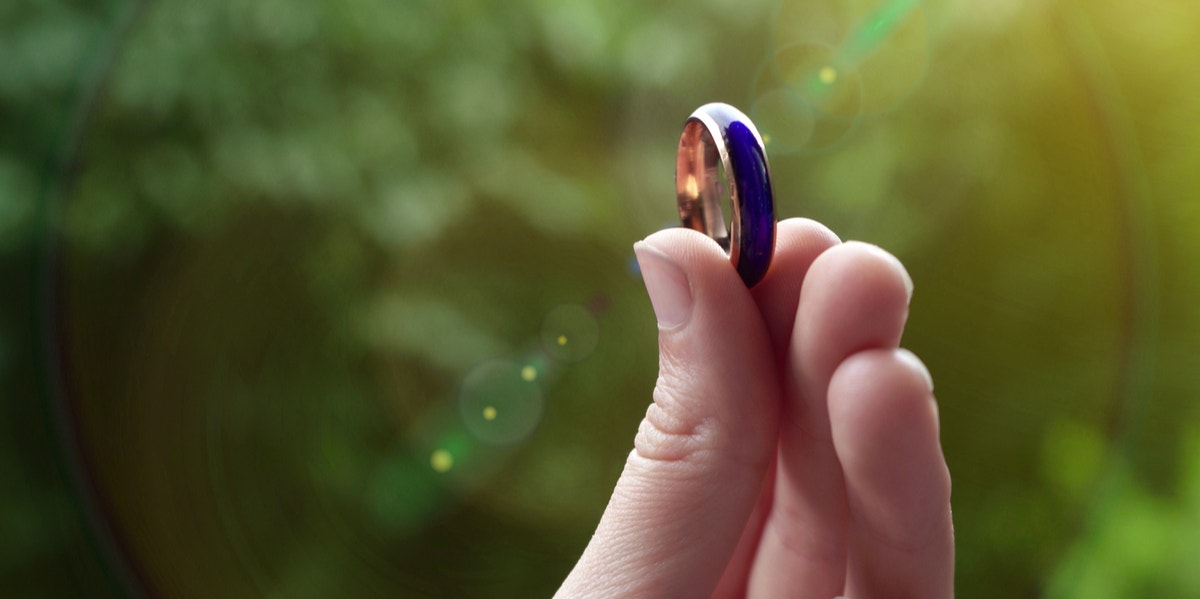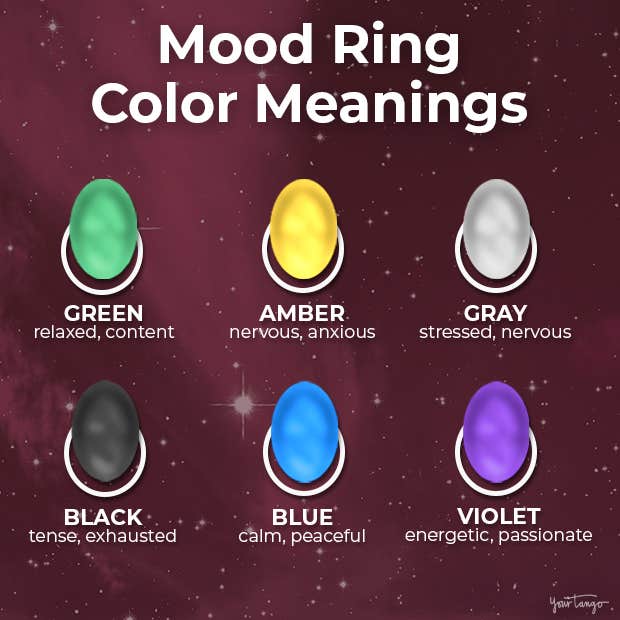Mood Ring Color Meanings Explained
In a mood? Maybe it's time for a mood ring.
 Ieva Makauskaite / Shutterstock.com
Ieva Makauskaite / Shutterstock.com Mood rings were created by New York inventors Maris Ambats and Josh Reynold in 1975. Some people call mood rings a fad of the 70s, but they seem to resurface often and have since taken the form of necklaces, bracelets, and even video game controllers in more recent years.
As nostalgic items from the 90s make a comeback, more and more people have begun to don mood rings on their fingers once again.
Mood Ring Color Meanings
Traditional mood rings dance between six main colors: green, blue, amber, gray, violet, and black.

Photo: YourTango
Green
The resting color, or the color that appears on a mood ring at an average body temperature, is green. This is when you’re not necessarily happy, sad, stressed, or relaxed. You just exist, maybe mindlessly watching TV or putting your hair up in a bun.
Amber
If you start to feel a little more anxious, the ring will shift to amber. An amber-colored ring shows that your body temperature has dropped just enough for the liquid crystals to change.
Gray
If the nerves get worse, the ring will continue to shift colors until it becomes gray.
Black
As your body goes into a state of panic or intense stress, the ring will turn black. Hopefully, you never get to this point!
Mood rings will also turn black when you take them off because they get cold.
Blue
As peace and calm settle in, the ring will shift to blue, showing that you’re feeling safe and stress-free.
Violet
Newer materials used to make mood rings have brought even more color options to the table.
A purple or violet color means that you are feeling energetic and passionate.
How do mood rings work?
As you might already know, mood rings are thermochromic, meaning that they change color in response to temperature changes. The color-changing part of the ring is made of a glass or quartz shell that is filled with thermochromic liquid crystals that change shape depending on their temperature, which causes them to reflect different colors of light.
So what does temperature have to do with your mood?
As soon as you put the ring on, the metal casting conducts your body heat to the ring’s crystals. Your temperature changes depending on your state of mind and body, which can indicate how you’re feeling.
For example, if you’re feeling stressed, your body sends blood to your inner organs, which naturally cools down your fingers. Then, your cold fingers cool down the mood ring, and the crystals change colors, which reveals your stressed mood.
Do mood rings actually tell your mood?
The short answer is… yes and no. While mood rings cleverly use thermochromic principles to monitor your body’s physical reaction to different situations, there are other factors that can easily alter your results.
For example, it might be a hot day, so your ring stays dark blue even if you’re miserable. Or you might have naturally cold hands that turn the ring black even though you’re the happiest person in the world.
It’s also important to note that, unless you’re a resident of Middle Earth, a ring can’t control you. Your body might react in one way to a stressful situation while your mind takes that energy and turns it into excitement. In this case, a mood ring would tell you one thing while your mind tells you the exact opposite.
Another thing to remember is that mood rings don’t last forever. When a mood ring stops responding to temperature changes (usually by turning black and staying black) it’s time for a new one.
Mood rings can stop working for a number of reasons, but the most common culprits are the exposure to extreme temperatures and getting old (the mood ring, not you!).
Susie Grimshaw is a writer for YourTango. Catch her covering all things love and relationships & entertainment and news.

